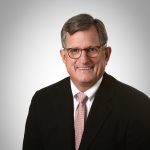Treatment of Degenerative Conditions of the Lumbar Spine: How the Total Posterior Spine System (TOPS™) Provides an Alternative Option to Surgery
Dr. Stephen Robbins, Wisconsin Bone & Joint, S.C.
Of all the bones in our body, the spine is one of the most familiar. Many of us are also familiar with the discomfort of back pain. If left untreated, back pain can cause significant impairment and lower your quality of life.
Because the spine is a crucial part of the musculoskeletal system and is the center support for the body, a healthy spine is vital. The spine connects all parts of the body and allows people to perform basic bodily movements such as standing, bending, and twisting. A spinal injury can result in being sidelined for a long time, but should an injury occur, there are often alternatives to spine surgery you can explore.
OHOW’s Dr. Stephen Robbins is an accomplished spinal surgeon with over 30 years of experience diagnosing and treating spine disorders.  He serves as a consultant for many spine health companies and is a current investigator of the Premia Spine Total Posterior Spine System (TOPS™) in treating lumbar spinal stenosis.
He serves as a consultant for many spine health companies and is a current investigator of the Premia Spine Total Posterior Spine System (TOPS™) in treating lumbar spinal stenosis.
Today, Dr. Robbins explains new, cutting-edge treatment options available to treat degenerative conditions of the lumbar spine and provide an alternative to fusion surgery. We’ll also learn more about degenerative spondylolisthesis and the different methods used to treat this condition.
DEGENERATIVE CONDITIONS OF THE LUMBAR SPINE
The spinal column contains 33 separate vertebrae stacked above one another, separated by discs that act as shock absorbers for the vertebrae. The vertebrae consist of four sections known as the cervical spine (neck), the thoracic spine (upper back), lumbar spine (lower back), sacral region (bottom of the spine), and the coccyx (tailbone).
Due to the complex and delicate nature of the spine, certain controllable factors such as excess weight, accidents or falls, and weak muscles impact spine health. You can keep your spine healthy with good posture and stretching. There are also less-preventable factors that play a role in spinal health, such as wear and tear due to aging, arthritis, and inherited disorders.
Degenerative conditions of the lumbar spine are widespread and can cause significant functional limitations in the aging population. Degenerative conditions affect the spine slowly over time, causing the loss of motion and reducing normal functions. These conditions are seen more frequently in older folks; as we age, our bones, joints, and ligaments in our spine weaken, allowing the spinal column to fall out of alignment. This may produce pain, pinched nerves, and spinal deformities.
One common degenerative condition of the spine, degenerative spondylolisthesis, produces significant episodes of lower back and leg pain with lower extremity weakness. In Latin, degenerative spondylolisthesis quite literally means, “slipped vertebral body.” The condition is characterized by slipping forward of one vertebra on another, narrowing the spinal canal diameter. The slippage produces pain, numbness, tingling, and weakness in the legs and impairs your ability to stand or walk for any distances.
TREATMENT FOR DEGENERATIVE SPONDYLOLISTHESIS
Typical treatment of degenerative spondylolisthesis includes physical therapy, anti-inflammatory medications, activity modifications, and epidural steroid injections. There are alternatives to spine surgery, especially if practitioners catch the condition early.
However, due to the progressive nature of the condition, surgical intervention is occasionally required. Studies have documented that once significant symptoms persist despite conservative care, surgical intervention provides a superior outcome.
The gold standard operation includes a lumbar laminectomy, fusion, and placement of instrumentation. The lumbar decompression—a.k.a., the laminectomy—is key to relieving leg pain. The fusion procedure is often necessary to provide stability by fusing two vertebral segments. This operation is often highly successful but limits the motion of the fused segment. As a result, stress increases on other levels of the spine, occasionally resulting in adjacent level degenerative changes, which may require future surgery.
THE TOTAL POSTERIOR SPINE SYSTEM
A new motion preservation device, the Total Posterior Spine System (TOPS™) developed by Premia Spine, provides a spine surgery alternative to the typical fusion procedure. The TOPS™ system is a mechanical device that replaces the bone and soft tissues removed during the spinal decompression. The TOPS™ device helps maintain the spine’s stability and preserves motion at that segment in all directions.
 The mechanical device is composed of two titanium plates that are connected by a polycarbonate urethane boot. The TOPS™ device is implanted in a procedure called ‘posterior arthroplasty.’
The mechanical device is composed of two titanium plates that are connected by a polycarbonate urethane boot. The TOPS™ device is implanted in a procedure called ‘posterior arthroplasty.’
The TOPS™ device has been demonstrated to provide excellent outcomes in appropriate patients and is presently being evaluated in a randomized FDA approved IDE investigation in 40 centers in the United States, including the Orthopaedic Hospital of Wisconsin. Dr. Stephen Robbins is the investigator at OHOW, participating in clinical trials of this groundbreaking device.
Despite the effectiveness, fusion procedures limit motion and change the mechanics of the lumbar spine. The TOPS™ device provides a spine surgery alternative to fusion and restores controlled movement in the damaged segment. The device typically doesn’t increase stress at other spinal levels, which leads to adjacent level degeneration. The TOPS™ motion preservation device can restore near-normal motion, improving patients’ short- and long-term functional outcomes.
If you’re suffering from spinal degeneration and in need of a consultation for a spine injury, the Orthopaedic Hospital of Wisconsin is here to help. We have an entire team of experienced orthopedic surgeons that will look to find the best treatment options to fit your needs. Contact us today to start your road to recovery and return to health.


